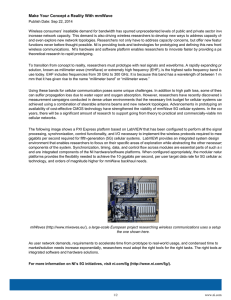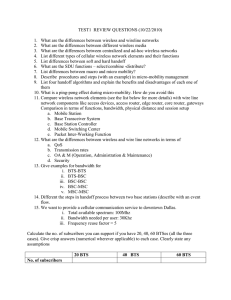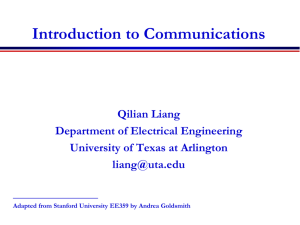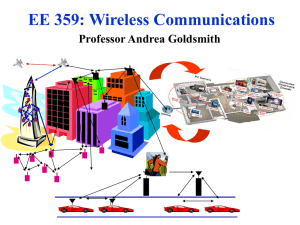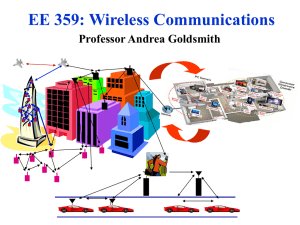Andrea Goldsmith - The National Academies
advertisement
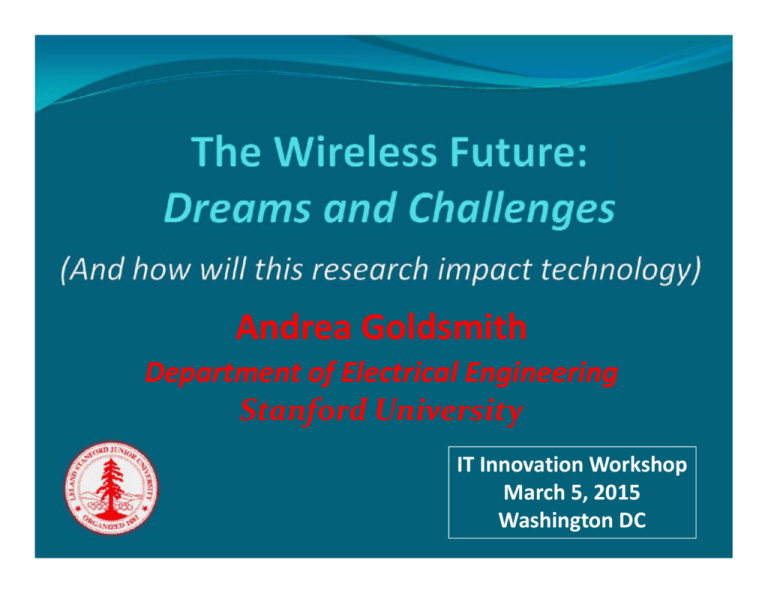
Andrea Goldsmith Department of Electrical Engineering Stanford University IT Innovation Workshop March 5, 2015 Washington DC Future Wireless Networks Ubiquitous Communication Among People and Devices Next-gen Cellular/WiFi Sensor Networks Smart Homes/Spaces Automated Highways Smart Grid Body-Area Networks Internet of Things All this and more … “Sorry America, your airwaves are full*” On the Horizon: “The Internet of Things” 50 billion devices by 2020 Source: FCC *CNN MoneyTech – Feb. 2012 3 IoT is not (completely) hype Number of Connected Objects Expected to Reach 50bn by 2020 Are we at the Shannon limit of the Physical Layer? We don’t know the Shannon capacity of most wireless channels — Time-varying channels. — Channels with interference or relays. — Cellular systems — Ad-hoc and sensor networks — Channels with delay/energy/$$$ constraints. Shannon theory provides design insights and system performance upper bounds Next wave in wireless research — Open problems in wireless network capacity and design — — — — — Channels and networks with feedback Rethinking cellular system capacity and design mmWave networks with large antenna arrays (massive MIMO) Ad-hoc and sensor network capacity and design Software-defined wireless networks — Back from infinity — Delay, complexity, and energy constraints — Expanding our horizons — Applying our analysis tools and methodologies to new disciplines — To obtain fundamental results Rethinking Cellular System Design Small Cell CoMP How should cellular systems be designed? Relay DAS Will gains be big or incremental; in capacity, coverage or energy? — Traditional cellular design assumes system is “interference-limited” — No longer the case with recent technology advances: — MIMO, multiuser detection, cooperating BSs (CoMP) and relays — Raises interesting questions such as “what is a cell?” — Energy efficiency via distributed antennas, small cells, MIMO, and relays — Dynamic self-organization (SoN) needed for deployment and optimization mmWave Massive MIMO ç10s of GHz of Spectrumè Dozens of devices Hundreds of antennas — mmWaves have large attenuation and path loss — For asymptotically large arrays with channel estimation, no attenuation, fading, interference or noise — mmWave antenna arrays are small — Bottlenecks: channel estimation and system complexity — Requires a complete rethinking of system design Wireless Sensor Networks • • • • • • § § § § Smart structures Smart roadways Search and rescue Homeland security Event detection Battlefield surveillance Energy (transmit and processing) is the driving constraint Data flows to centralized location (joint compression) Low per-node rates but tens to thousands of nodes Intelligence is in the network rather than in the devices Wireless networks are everywhere, yet… White Space & Cognitive Radio Ad-hoc/Sensor networks - Connectivity is fragmented - Capacity is limited (spectrum crunch and interference) - Roaming between networks is ad hoc Software-Defined Network Architecture Video Freq. Allocation Vehicular Networks Security Power Control Self Healing ICIC M2M QoS Opt. App layer SW layer Health CS Threshold UNIFIED CONTROL PLANE Commodity HW WiFi Cellular mmWave Cognitive Radio Wireless and Health, Biomedicine and Neuroscience Body-Area And In-Body Networks Doctor-on-a-chip -Cell phone info repository -Monitoring, remote intervention and services Cloud The brain as a network - EKG signal reception/modeling - Implants to monitor/generate signals - In-brain sensor networks - Signal injection as medical intervention - Signal encoding and decoding - Neural connectivity modeling Why I did a startup • Not to make $$$$ • To build something (again) Silicon Valley 1986 20 Years Lots of Theory • To build state-of-the-art products grounded in deep theory, and see how they worked • To bring back new knowledge to my research and teaching Lessons Learned — Academics have a great job — Info./Comm. Theory heavily influence wireless system design (mainly at the PHY & MAC layers) — A chip with 30 years worth of Info./Comm theory costs $5. — Wireless systems grounded in deep theory work better — Complexity drives cost, size, and energy consumption — Many aspects of wireless systems poorly understood Communications research has had a lot of impact on IT — — — — — Converting the analog world to bits (A/Ds, sampling, quantization) Compression and storage (voice, images, video, data) Data processing (“Big Data”) Wireless/wired networks (WiFi, Cellular, BT, Cable, DSL, satellite) The “Cloud”: Communications, storage, and data processing Summary — Much research needed to realize the wireless vision — This vision will enable new applications that will change people’s lives worldwide — Research has a profound impact on technology development, and vice versa. Thanks to NSF, ONR, DARPA, AFOSR, & DTRA for research support



